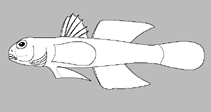Upload your photos and videos
Google imageNo image available for this species;
drawing shows typical species in Gobiidae.
Google imageNo image available for this species;
drawing shows typical species in Gobiidae.
Classification / Names Populärnamn | synonymer | Catalog of Fishes(Släkte, Arter) | ITIS | CoL | WoRMS | Cloffa
> Gobiiformes (Gobies) > Gobiidae (Gobies) > Gobiinae
Etymology: Mahidolia: Named for His Royal Highness Prince Mahidol of Songkla, for his interest in the fishes and fisheries of Siam (Smith, 1932 original publication); paucipora: Name from Latin 'paucipora' for few pores, referring to the reduced pattern of cephalic sensory-canal pores; a feminine compound adjective.
Eponymy: Mahidol Adulyadej (1892–1929), Prince of Songkla, was honoured for his interest in the fishes and fisheries of Siam (Thailand). (Ref. 128868), visit book page.
Etymology: Mahidolia: Named for His Royal Highness Prince Mahidol of Songkla, for his interest in the fishes and fisheries of Siam (Smith, 1932 original publication); paucipora: Name from Latin 'paucipora' for few pores, referring to the reduced pattern of cephalic sensory-canal pores; a feminine compound adjective.
Eponymy: Mahidol Adulyadej (1892–1929), Prince of Songkla, was honoured for his interest in the fishes and fisheries of Siam (Thailand). (Ref. 128868), visit book page.
Environment: milieu / climate zone / depth range / distribution range Ekologi
marina revassocierade; djupintervall 14 - 27 m (Ref. 120714). Tropical
Utbredning Länder | FAO områden | Ekosystem | Förekomster | Point map | Utplanteringar | Faunafri
Western Pacific: Papua New Guinea.
Size / Vikt / Age
Maturity: Lm ? range ? - ? cm
Max length : 2.3 cm SL (female)
Max length : 2.3 cm SL (female)
Short description Bestämningsnycklar | Morfologi | Morfometri
Taggstrålar i ryggfenan (totalt) : 7; Mjukstrålar i ryggfenan (totalt) : 10; Taggstrålar i analfenan: 1; Mjukstrålar i analfenan: 8 - 9; Ryggkotor: 26. This species is distinguished by the following characters: D VI-I,10, dorsal fin without elongate spines, longest spine 1.9-2.8 in HL; A I,8-9 (usually 9); pectoral-fin rays 15-16 (usually 16); lateral scales 35-37; body scales are weakly ctenoid, except cycloid anteriorly, including side of nape, abdomen, pectoral-fin base, and prepelvic area; gill rakers 2-3+11-12; gill opening extending slightly forward of level of posterior margin of preopercle; caudal fin rounded, about equal to HL, 3.2 in SL; reduced pattern of cephalic sensory-canal pores consisting of only B’, D, E, F, and H pores. Colouration: body mostly whitish with five widely spaced brown bars, and first dorsal fin mainly whitish with a prominent posterior white-edged black spot. This is apparently small size species, with mature females < 20 mm SL (Ref. 120714).
The type locality is a narrow isolated patch reef that rises to within 1 or 2 m of the surface from a depth of about 30 m and approximately 8 solitary individuals were observed at this location on a silty-sand and rubble bottom. It was invariably seen at the entrance of a burrow in company with an unidentified species of alpheid shrimp (Ref. 120714).
Life cycle and mating behavior Könsmognad | Reproduktion | Lek | Ägg | Fecundity | Larver
Main reference
Upload your references | referenser | Koordinator | Medarbetare
Allen, G.R. and M.V. Erdmann, 2019. Mahidolia paucipora, a new species of shrimpgoby (Teleostei: Gobiidae) from Papua New Guinea. J. Ocean Sci. Found. 32:79-88. (Ref. 120714)
IUCN Red List Status (Ref. 130435: Version 2024-2)
Data deficient (DD) ; Date assessed: 14 November 2023
CITES
Not Evaluated
Threat to humans
Harmless
Human uses
FAO - Publication: search | FishSource |
Ytterligare information
Trophic ecology
Födoslag
Födosammansättning
Födointag
Food rations
Predatorer
Födoslag
Födosammansättning
Födointag
Food rations
Predatorer
Ecology
Ekologi
Ekologi
Population dynamics
Tillväxtparametrar
Max. ages / sizes
Length-weight rel.
Length-length rel.
Length-frequencies
Mass conversion
Rekrytering
Abundans
Tillväxtparametrar
Max. ages / sizes
Length-weight rel.
Length-length rel.
Length-frequencies
Mass conversion
Rekrytering
Abundans
Life cycle
Reproduktion
Könsmognad
Maturity/Gills rel.
Fecundity
Lek
Spawning aggregations
Ägg
Egg development
Larver
Larvdynamik
Reproduktion
Könsmognad
Maturity/Gills rel.
Fecundity
Lek
Spawning aggregations
Ägg
Egg development
Larver
Larvdynamik
Anatomy
Gälyta
Brain
Otolith
Gälyta
Brain
Otolith
Physiology
Body composition
Nutrients
Syreförbrukning
Swimming type
Simhastighet
Visual pigments
Fish sound
Diseases & Parasites
Toxicity (LC50s)
Body composition
Nutrients
Syreförbrukning
Swimming type
Simhastighet
Visual pigments
Fish sound
Diseases & Parasites
Toxicity (LC50s)
Genetics
Genetik
Heterozygosity
Ärftlighet
Genetik
Heterozygosity
Ärftlighet
Human related
Aquaculture systems
Vattenbruksprofiler
Avelslinjer
Ciguatera cases
Stamps, coins, misc.
Aquaculture systems
Vattenbruksprofiler
Avelslinjer
Ciguatera cases
Stamps, coins, misc.
Verktyg
E-book | Fälthandbok | Längdfördelnings-verktyg | Livshistorie-verktyg | Prickkarta | Classification Tree
| Catch-MSY |
Special reports
Download XML
Internet-källor
AFORO (otoliths) | Aquatic Commons | BHL | Cloffa | BOLDSystems | Websites from users | Check FishWatcher | CISTI | Catalog of Fishes: Släkte, Arter | DiscoverLife | ECOTOX | FAO - Publication: search | Faunafri | Fishipedia | Fishtrace | GenBank: genome, nucleotide | GloBI | Google Books | Google Scholar | Google | IGFA World Record | MitoFish | Otolith Atlas of Taiwan Fishes | PubMed | Reef Life Survey | Socotra Atlas | Tree of Life | Wikipedia: Go, sök | World Records Freshwater Fishing | Zoobank | Zoological Record
Estimates based on models
Phylogenetic diversity index (Ref. 82804): PD50 = No PD50 data [Uniqueness, from 0.5 = low to 2.0 = high].
Bayesian length-weight: a=0.00724 (0.00339 - 0.01546), b=3.10 (2.92 - 3.28), in cm total length, based on LWR estimates for this (Sub)family-body shape (Ref. 93245).
Trofisk nivå (Ref. 69278): 3.1 ±0.3 se; based on size and trophs of closest relatives
Resiliens (Ref. 120179): Hög, lägsta populationsfördubblingstid mindre än 15 månader (Preliminary K or Fecundity.).
Fishing Vulnerability (Ref. 59153): Low vulnerability (10 of 100).




